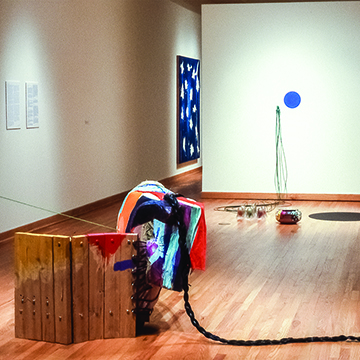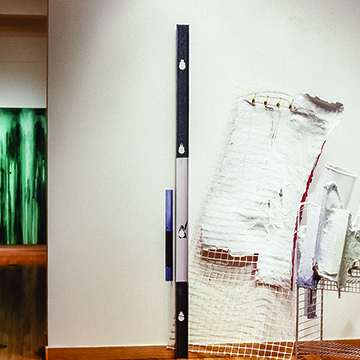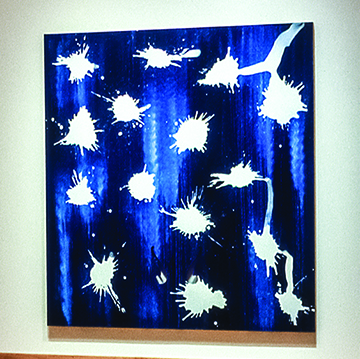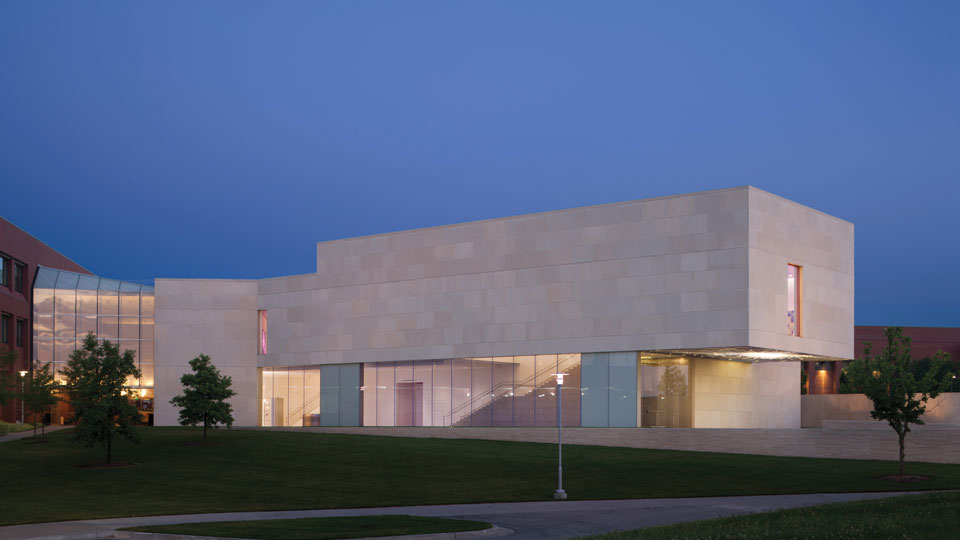The Point of Departure
Moira Dryer and Jessica Stockholder
Artists Moira Dryer and Jessica Stockholder have extended the field of painting by their use of objects and constructed elements, and, in the case of Stockholder, literally blurred the lines between painting and sculpture. The two artists embraced abstract painting at a time when novelty, cynicism and irony had become the most acceptable approaches to artmaking. Although sharing the tradition of testing the limits of painting's format is their point of origin, Dryer and Stockholder arrive and depart from this juncture according to very different agendas.
Moira Dryer’s richly hued and often unconventionally designed paintings and assemblages are thinly painted with saturated washes and bursts of color. In the works, which are sometimes cut into odd shapes or mounted to project from the wall, component of classic modernism – for example, the target imagery of Jasper Johns and Kenneth Noland, the stripes of Bridget Riley or Frank Stella, drips and stains recalling the conventions of Abstract Expressionism and Color Field painting – are combined in a variety of unusual and frequently ironic ways. As Dryer remarked, “An artist who is versed in history, and most are so educated, cannot approach their work in a way that eliminates their education.” Rather than avoid codified styles, she mixed them in ways that liberated them from their set formal or historical associations.
In works such as Pop, included in the exhibition, Dryer placed cantilevered shelves or boxes under the main unit. Around 1989, some of her paintings began to feature arcing, striated designs, based on blowups of her own fingerprints. By 1990, her increasingly expansive panels featured perforations, grommets, rubber stoppers, and elaborate jigsawed arabesques which mimic the f-holes in the face of a cello.
Dryer once stated, “I have utilized the tradition of reductive geometric painting, but I’ve never been interested in it as a pure form of abstraction. Instead, I thought of it as a language to combine with other painting languages ... for instance, I wanted to suggest portraiture, landscape and still-life, but I used geometry as a framework to do it, so that one set of preconception would erase another. That way I was able to use minimal means to convey, I hope, real feeling.”
Dryer was born in 1957 in Toronto, and she died in 1992. She attended Sir George Williams University in Montreal and then transferred to the School of Visual Arts in New York City. There she studied with the painter Elizabeth Murray and graduated with honors in 1981. Dryer's work has been included in numerous group exhibitions in museums and galleries around the country. Her first solo exhibition was held in 1986 at the John Good Gallery in Manhattan, New York, and there were subsequent solo shows at the Institute of Contemporary Art and the Mario Diacono Gallery in Boston, and the Fred Hoffman Gallery in Santa Monica, California. She has exhibited at the San Francisco Museum of Modern art and the Museum of Modern Art and Mary Boone Gallery in New York.
Jessica Stockholder has become well known for her mixed media assemblages which utilize diverse, commonplace materials. Although her smaller autonomous sculptures and site-specific installations exist in three dimensions, Stockholder’s work has become crucial in the ongoing dialogue about the increased possibilities of painting. She is one of a generation of artists who have broken down the boundaries between painting, sculpture and architecture to create a new perceptual space. Found objects ranging from oranges to neon tubes, discarded household fabrics and decontextualized building materials are massed and lyrically intertwined with a profusion of vivid color. Her architectonic installations engulf the viewer; they recall Schwitters’ Dadaist collages, spliced with the formal concerns of the 1950s abstract painting and redefined through a postmodern sensibility.
According to Terrie Sultan, Curator of Contemporary Art at the Corcoran Gallery of Art, Washington, DC, “Stockholder structures her fusions of found objects, fabric, yarn, and bits and pieces of everyday stuff as shapes and lines in space, essentially painting in three dimensions. But the physical dynamic of her compositions – alternatively rhythmic and chaotic – consciously diagrams formal beauty as a tangible abstraction. Scavenging the art history of Abstract Expressionism, Color Field, Minimalism, Pop, and Assemblage, she achieved a fusion capable of cramming the color, shape and surface of conventional painting into the space, volume, weight and mass associated with sculpture.”
Born in Seattle in 1959, Stockholder was raised in Vancouver, Canada. She received her BFA from the University of Victoria in Canada in 1982 and her MFA from Yale University in 1985. She has exhibited widely in North America and Europe at such venues as Dia Center for the Arts, the Whitney Museum of American Art, P.S. 1, and Mitchell-Innes & Nash Gallery, New York; SITE Santa Fe; Venice Biennale; Kunstmuseum St. Gallen; Centre Pompidou, Paris; Open Air Museum, Middelheim, Belgium; and Power Plant, Toronto, Canada.
Her work is represented in many important public and private collections including the Albright-Knox Art Gallery, the Art Institute of Chicago, the Corcoran Gallery of Art, Whitney Museum of American Art, LACMA, Vancouver Art Gallery, and Stedelijk Museum in Amsterdam. She has received numerous awards including the Lucelia Artist Award from the Smithsonian American Art Museum, a Guggenheim Fellowship and several grants from the Canada Council. Stockholder was appointed to the Yale University faculty in 1999.
The gallery guide features an essay by Saul Ostrow, New York. Ostrow is an artist, critic, curator and editor of BOMB Magazine, co-editor of Lusitania Press and general editor for the Critical Voices Series for the Gordon and Breach Publishing Group Arts International. He teaches critical theory at New York University and the School of Visual Arts and in the graduate program at Parsons School of Design. Ostrow will present a lecture, “More Parts to the Whole: Abstract Painting After Modernism,” in conjunction with the opening.





